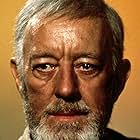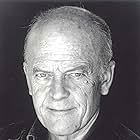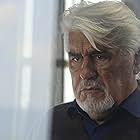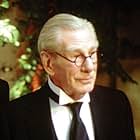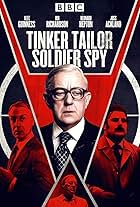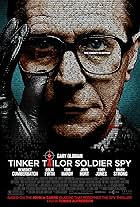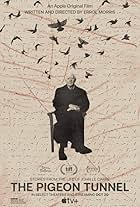The murder of a Soviet defector forces his old handler, British spymaster George Smiley, out of retirement. His investigation leads to an old nemesis, the Soviet spymaster known only as "Kar... Read allThe murder of a Soviet defector forces his old handler, British spymaster George Smiley, out of retirement. His investigation leads to an old nemesis, the Soviet spymaster known only as "Karla". This will be their final dance.The murder of a Soviet defector forces his old handler, British spymaster George Smiley, out of retirement. His investigation leads to an old nemesis, the Soviet spymaster known only as "Karla". This will be their final dance.
- Nominated for 3 Primetime Emmys
- 4 wins & 9 nominations total
Storyline
Did you know
- TriviaSimon Langton was brought in to direct this mini-series after Sir Alec Guinness demanded a change of directors because the initially assigned director had a reputation for bullying actors and actresses.
- GoofsWhen Smiley is talking to Connie Sachs, she mentions that Karla once had a mistress, upon which Smiley's eyes widen, and with an utterly surprised look, he asks "Who?" She then goes on to tell about how Karla also had a daughter from that relationship.
It's impossible that George Smiley, who spent most of his life gathering every bit of detail about Karla, and even wrote "The Karla papers" (according to Saul Enderby) wouldn't know about such a vital piece of information about his nemesis.
- Quotes
Lauder Strickland: Oh dammit, George, that whole era is dead.
George Smiley: And so is Vladimir! And I wish to God we'd got half his courage and one tenth his integrity.
- Crazy creditsThe opening titles feature a set of wooden planks, on which yellow chalk marks (the secret signal used by the spies) are scrawled.
- ConnectionsFeatured in The 35th Annual Primetime Emmy Awards (1983)
That's all fine. The series is from the great BBC tradition in narrative: the acting is uniformly excellent, it is a clean and riveting piece of fiction. Moreover, it is filmed in that BBC way I adore—transparent camera, natural light and textures.
Which brings me to a point I made in my Tinker Tailor post. I recommend this simply on its storytelling capacity to immerse you. And if you want a glimpse of how 1970's West Europe was like, it is indispensable viewing, absolutely so.
But, it's also a spy film, and a spy film is to my mind one of the best templates for cinematic meditation.
Here's what I mean. You enter a world of some complexity that has machinery and movement, but enter long after the machinery has been set in motion. In the films, you (in the detective's shoes) are looking for this or that narrative device, here it turns out to be a girl, doesn't matter.
In this film, the story really has started long before we enter, but you only learn this as you move through the first couple of episodes—in other words, midway through you suddenly have memories of this world. (one episode is capped by Smiley actually having a flashback)
So, because you have only a partial view of the story (reflected in the film in a crucial bit of evidence being a film strip), and the story shifts as you move through (indeed, you don't know there is a testimony that goes with the strip), this would be like a chess game where each new move shuffles the rules, trying to make sense is not enough. You will have to be still long enough for the thing to reveal itself. You have to spy.
Isn't this nice? You as a viewer will have to be able to see every corner while not being bogged down by detail. Indeed, whereas the bulk of intelligence operatives work as analysts, a good analyst is worth his weight in gold because he does just this: he can flow through a sea of information, salvaging only the crucial bits, the anchors that explain the story.
So, my notion of a good spy film is one that makes watching itself have agency in the world—any film would benefit from this, hence why a template. This is a step-up from Tinker Tailor, where after each episode we were summoned for a recap by the master sleuth, everything smoothed out for us.
Oh, later episodes are forwarded by explanatory monologues and the story, as it turns out, is a personal bet so doesn't threaten an empire, but you have this structure and double identity of the girl at the center, which are fresh and powerful devices. And the sense of place is powerful —Paris, the Hamburg strip club and lake camp, quiet picturesque Bern, Berlin and the simmering anxiety of the Wall.
But the best piece of news is this: there is talk of a sequel to the recent Tinker Tailor film, which is going to be this one (alas for 'Schoolboy').
The film has what both of these don't, though they are otherwise excellent. It has abstraction in the film. It has not just the 'magicians' tricks, but magic that alters how we see. So, I'm hoping they go ahead with it, they will be building—as the first time—from a great primary text.
- chaos-rampant
- Dec 25, 2012
- Permalink
- How many seasons does Smiley's People have?Powered by Alexa
Details
- Release date
- Country of origin
- Language
- Also known as
- John le Carré's Smiley's People
- Filming locations
- Lady Bay Bridge, Nottingham, Nottinghamshire, England, UK(West Berlin checkpoint)
- Production companies
- See more company credits at IMDbPro
Contribute to this page
















